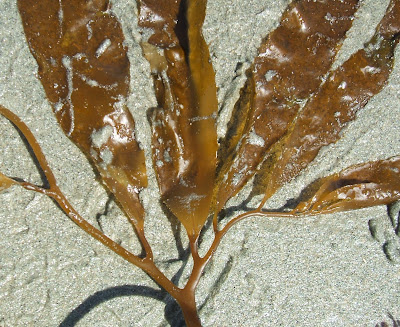
Mussels can be a dominate organism in many rocky intertidal communities. Unlike other permanent residents, like barnacles and algae that are permanently attached to the rocks, mussels can move short distances by creating byssal threads. The byssal threads are primarily used as a means of attachment, but by creating and attaching new byssal threads and cutting lose from old ones, mussels can pull themselves along rocky shores.
People who walk around in the intertidal may notice, like the authors of a cool article featured in Science, that mussels often cluster in interesting patterns on the rocks. The authors found that the size of the clusters and the pattern of the clusters is consistent among mussel beds (with similar mussel densities), set out to determine why.
They found that if you spread mussels out evenly in the laboratory, they will spontaneously form clusters similar to those seen in the field, even in the absence of the rocky substratum and wave action found in the field. They also found that if you place mussels in various-sized clusters at the start, there is a difference in movement based on initial cluster size. Mussels in small clusters (with 2-8 individuals) and mussels in large clusters (with 128 individuals) tended to move around and rearrange themselves a lot more than medium size clusters. So, mussels really want to be in a cluster of a certain size... but why?
Large clusters have may have a food limitation. With all of their neighbors filter feeding, having to many individuals around you may limit the amount of food you can capture. When the authors squirted food in the middle of large clusters, the individual mussels were pretty content to stay in the large cluster. But if clustering reduces food, why cluster? When placed back out in the field, individuals who were not in a cluster were more likely to be knocked off by wave action.
So, individual mussel will gather together in a cluster, but when the neighborhood gets too crowded they move. By arranging themselves in the rather interesting maze-like pattern of clusters and spaces often seen in the intertidal, individuals get protection from wave action, and have a higher growth rate than densely-packed mussel beds.
Van de Koppel, J., J. Gascoigne, G. Theraulaz, M. Rietkerk, M. Mooij, and P. Herman. 2008. Experimental evidence for spatial self-organization and its emergent effects in mussel bed ecosystems.
Science.
322:739-742.





 This is a picture of a collection of artifacts I have in my house. The collection is often a surprise to most visitors, but give who we generally hang out with, it ends up being a fascinating conversation piece. Not only does our collection offer a glimpse at our inner geekyness to visitors, but they are often used as educational tools for the various classes and fairs that we teach. Most of these items were gotten from the various institutions that me and my husband have worked at or volunteered for over the years. Often, when departments have to move their collections, things get stuck in a cardboard box in the back halls with a sign saying "free, take me home!".
This is a picture of a collection of artifacts I have in my house. The collection is often a surprise to most visitors, but give who we generally hang out with, it ends up being a fascinating conversation piece. Not only does our collection offer a glimpse at our inner geekyness to visitors, but they are often used as educational tools for the various classes and fairs that we teach. Most of these items were gotten from the various institutions that me and my husband have worked at or volunteered for over the years. Often, when departments have to move their collections, things get stuck in a cardboard box in the back halls with a sign saying "free, take me home!". 













